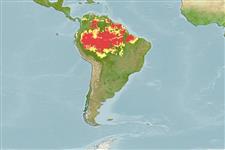Klassifizierung / Names
Namen | Synonyme | Catalog of Fishes (gen., sp.) | ITIS | CoL | WoRMS | Cloffa
Actinopterygii (Strahlenflosser) >
Beloniformes (Needle fishes) >
Belonidae (Needlefishes)
Etymology: Potamorrhaphis: Greek, potamos = river + Greek, rhaphis = needle (Ref. 45335).
Lebensraum / Klimazone / Range
Ökologie
; süßwasser pelagisch; tiefenbereich 0 - ? m. Tropical; 23°C - 26°C (Ref. 2059), preferred ?
South America: Amazon and Orinoco River basins, and the Guianas.
Size / Gewicht / Alter
Maturity: Lm ? range ? - ? cm
Max length : 29.1 cm TL Männchen/unbestimmt; (Ref. 40653); common length : 12.3 cm OT Männchen/unbestimmt; (Ref. 10994)
Kurzbeschreibung
Morphologie | Morphometrie
Rückenflossenstacheln (insgesamt): 0; Rückenflossenweichstrahlen (insgesamt): 29-36; Afterflossenstacheln 0; Afterflossenweichstrahlen: 25 - 32; Wirbelzahl: 68 - 78. Predorsal scales 85-135, mean 110.3 (Ref. 10994, Table 7).
Forms schools at the surface. Prefers to inhabit marshes, small slow-moving creeks or even in main river beds, in the slowest parts of meandering streams next to banks (Ref. 35237). Voracious carnivore which appears to have a primarily nocturnal habit (Ref. 27188). During reproduction, the male positions itself beside the female or crosswise in front of her. Sometimes the male touches the female with his side, pushing her aside in an oblique position, with their heads oriented downwards. The couple settles next to a bush where the female spawns her eggs (15 to 40). Eggs adhere to plants by means of sticky filaments which are 2 to 3 mm long. At 27-30°C, incubation lasts for 9 to 10 days. Larvae are pelagic and carnivorous (Ref. 35237). Maximum length 40 cm TL in Keith et al., 2000 (Ref. 35237).
Life cycle and mating behavior
Geschlechtsreife | Fortpflanzung | Ablaichen | Eier | Fecundity | Larven
The eggs are attached to underwater vegetation. At 27-30 deg. Celsius the larvae hatch after 9 - 10 days. The larvae are pelagic carnivores.
Collette, B.B., 1982. South American freshwater needlefishes of the genus Potamorrhaphis (Beloniformes: Belonidae). Proc. Biol. Soc. Wash. 95(4):714-747. (Ref. 10994)
IUCN Rote Liste Status (Ref. 115185)
CITES (Ref. 94142)
Not Evaluated
Bedrohung für Menschen
Harmless
Nutzung durch Menschen
Mehr Information
Alter/GrößeWachstumLänge-GewichtLänge-LängeLängenhäufigkeitenMorphometrieMorphologieLarvenLarven Pop.Dyn.RekrutierungDichte
ReferenzenAquakulturAquakultur ProfilZuchtlinienGenetikAllel-HäufigkeitenVererbbarkeitKrankheitenVerarbeitungMass conversion
PartnerBilderStamps, CoinsLauteCiguateraGeschwindigkeitSchwimmstilKiemenoberflächeOtolithsGehirngrößeSehfähigkeit
Tools
Zusatzinformationen
Download XML
Internet Quellen
